|
W o r l d W a r I I
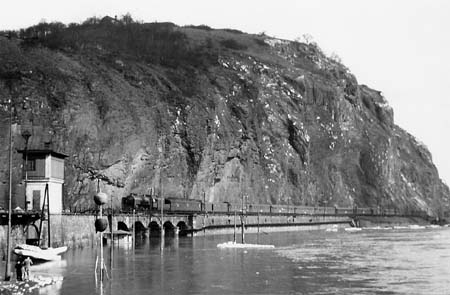
D148 Berlin - Balkan, Czech Pacific 387.028, Aussig, Feb. 1940 (Wilhelm Tausche)
|
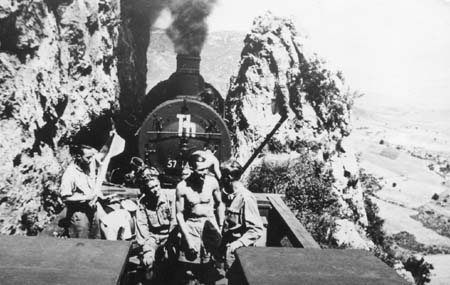
German 57 1377 hauling a train in Greece near Lianokladion, 1941 (coll. Dr. Hansjuergen Wenzel)
|
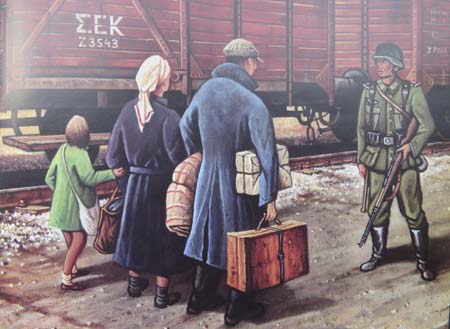
KZ transport from Greece, a painting by Georgeos Handrinos
|
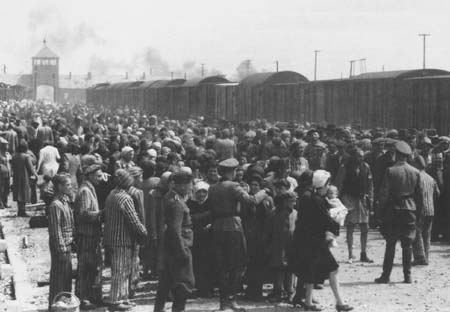
Arrival of a KZ transport at Auschwitz-Birkenau on 27May 1944 (E. Hofmann, B. Walter, collection G. Handrinos/ SFS)
|
The war stopped the Grand Expresses in September 1939, but in 1940 for a short time an Orient-Express Munich-Bucharest and the Simplon-Orient-Express from Lausanne eastward resumed services. From 1941 only its Berlin branch, the D148, did run to Sofia as SF 947. At Pecs in Hungary from 1942 a Mitropa car from Paris was added, which in France was combined with a Mitropa service Hendaye - Berlin, the connection between Franco's Spain and Hitler's Reich. And in Belgrade CIWL sleepers from Rome and Torino to Sofia were added until Mussolini's fall in 1943. In Germany the Berlin - Sofia train probably was hauled by a streamlined 0110 and in Slovakia even by the unique 05-style streamlined 386.001 Pacific. In Serbia up to seven wagons against landmines were pushed by the Serbian locomotive and a wagon with a gun was attached, as a frequent traveler and SS courier told to the author. After the war he once again traveled on military expresses, the Medloc trains. Now he served as a British official….
The author, a schoolboy then, once in 1950 or 51 in the small town Geisenheim was dazzled by a train passing during night, with cars never seen before. Much later he learned that this were British cars and the train was a Medloc, introduced originally to carry British troops home.
SF947
Departure Belgrade, according to DR Zp June 1944
(these Mitropa sleepers were stopped in September 1944):
| BC (2nd 3rd class) | Serbian | Belgrade - Nish |
| WLAB (sleeper) | ex-CIWL | Belgrade - Nish (for civil) |
| WLAB | Mitropa | Budapest - Sofia |
| WLAB | Mitropa | Berlin - Sofia (D148/DmW35) |
| WLAB | Mitropa | Paris - Sofia (D391/148/35) |
| BC (2nd 3rd class) | BDZ | Belgrade - Sofia (for Bulgarian army) |
| AB (1st 2nd class) | Serbian | Belgrade - Sofia (for German army) |
| C (3rd class) | Serbian | Belgrade - Sofia (for German army) |
| ABC (1st 2nd 3rd) | Serbian/DR | Vienna - Sofia (for civil) |
| AB (1st 2nd) | Serbian | Belgrade - Sofia (for civil) |
| C (3rd class) | Serbian | Belgrade - Sofia (for civil) |
| D (van) | Serbian | Belgrade - Sofia (for civil) |
| Post (postal van) | Serbian | Belgrade - Sofia (for civil) |
Connecting service Sofia - Istanbul with change of trains a the border.
SF948
Departure Belgrade, according to DR Zp. June 1944 Belgrade - Athens for German army only: C, D, AB, BC, D, Post (all cars Serbian).
Colors: All these trains were grey, either by paint or by smoke.
Medloc A:
From June 1945 Toulon - Toulouse - Vierzon - Pontoise - Dieppe, from 1946 Toulon - Beaune - Calais, then stopped. Ex-Prussian, ex-DR and LNER cars.
Medloc B:
From July 1945 Milan - Simplon - Calais, up to 4 trains daily, in 1946 stopped. Green, brown/beige or silver FS cars, 1 CIWL train, 2 SBB trains, 1 hospital train.
Medloc "feeder":
From 1945 Naples - Rome - Milan, Taranto - Rimini - Milan, 1946 Bari - Foggia - Naples - Ancona - Milan. FS cars, also box cars.
Medloc C:
From October 1945 Seebach (near Villach) - Munich Ludwigsfeld - Pagny - Lille - Calais, temporarily from Trieste. In 1947 there was a Medloc Verona - Munich Ludwigsfeld - Strasburg - Lille - Calais. From 1948 Medloc C Hoek - Krefeld - Mainz/Frankfurt - Karlsruhe - Munich Ludwigsfeld - Seebach, temporarily extended via Villach to Vienna.
Medloc C:
DBA 668, Zp Oct. 8, 1950:
| 1D | Hoek - Seebach b. Villach |
| 1 AB | Hoek - Seebach b. Villach |
| 1 WLAB | Hoek - Seebach b. Villach |
| 1 WR | Hoek - Seebach b. Villach |
| 1 D | Hoek - Seebach b. Villach |
| 1 WR | Hoek - Seebach b. Villach |
| 1 AB | Hoek - Seebach b. Villach |
| 1 Heizw. | Krefeld - Seebach b. Villach |
| 4 C | Hoek - Seebach b. Villach |
| 1 GmhS | Düsseldorf - Seebach b. Villach |
British and CIWL cars. The appearance was grey from smoke.
In 1945 initially there had been SNCF, possibly FS, then British and CIWL cars, from 1953 NS, OeBB and DSG cars. The last return journey with the special car of the commander of BTA was in 1955 (literature: Hurst/Elliot, Show me the Way to go home).
From 1945 for a short time there were the expresses DUS607/608 Paris - Munich Oberwiesenfeld/ Nurnberg and DUS 705/706 Nice - Karlsruhe - Munich Oberwiesenfeld/ Nurnberg Roethenbach for American forces. On August 22, 1945 started a regular U.S. Army express from Vienna Franz-Josefs-Bahnhof in the American sector to Linz via Langenlebarn, where the U.S. forces had their airfield. A photograph shows an ex-Hungarian 424 class 4-8-0 type engine with American flags, but also classes 19, 33, 50, 52 and on the main line electric engines hauled the train. Initially an American war-type locomotive pushing two wagons secured the line. From December 1945 the train ran to Munich, including CIWL sleepers with the U.S. label, from 1952 only to Salzburg and in October 1955 came the end for this train, which had become known as the "Mozart".
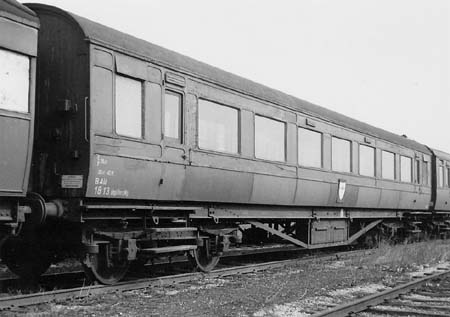
British Medloc cars, Meidling near Vienna, March 11, 1953 (Ernst Wolf)
|
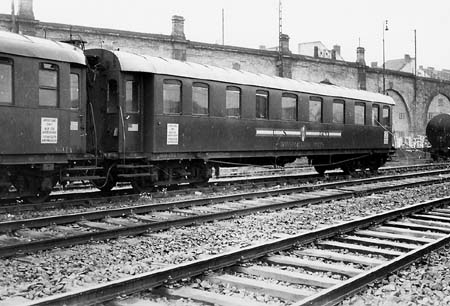
Austrian cars for "Mozart", the U.S. Army express, at Vienna Franz-Josefs-Bahnhof in October 1952 (Ernst Wolf)
|
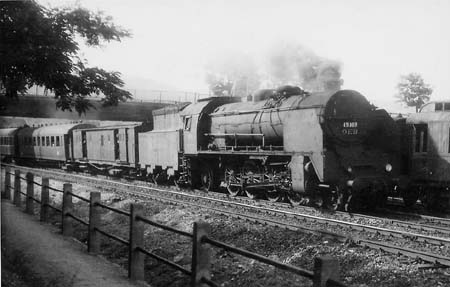
One of the first regular "de Luxe" trains after the war: Arlberg-Orient-Express, OeBB Mikado 19.109, ex Pt31 from Poland, west of Vienna in 1946 (Franz Kraus)
|








